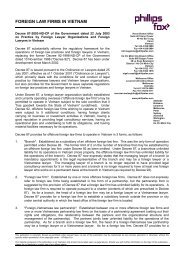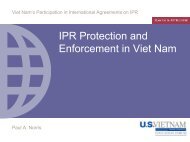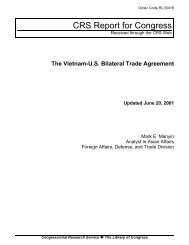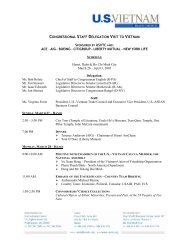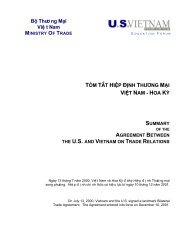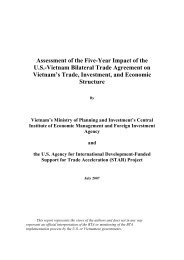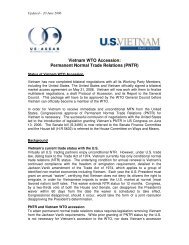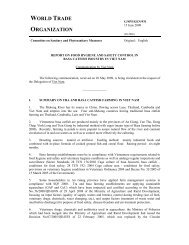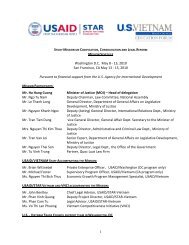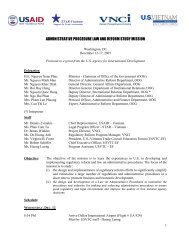Climate risks and adaptation in Asian coastal megacities: A synthesis
Climate risks and adaptation in Asian coastal megacities: A synthesis
Climate risks and adaptation in Asian coastal megacities: A synthesis
- No tags were found...
You also want an ePaper? Increase the reach of your titles
YUMPU automatically turns print PDFs into web optimized ePapers that Google loves.
■■■■■■For the eastern part of Bangkok, pump<strong>in</strong>g capacityto dra<strong>in</strong> floodwater <strong>in</strong>to the Bang Pakong River<strong>and</strong> the Gulf of Thail<strong>and</strong> needs to be <strong>in</strong>creased. Basedon simulations, the study considers <strong>in</strong>vestmentsthat would <strong>in</strong>crease pump<strong>in</strong>g capacity from737 to 1,065 m 3 /sec. The total capacity of canalswould be improved from 607 to 1,580 m 3 /sec.In western Bangkok, there are three majorpump<strong>in</strong>g stations at Khlong Phasi Charoeng,Sanam Chai, <strong>and</strong> Khun Rat Ph<strong>in</strong>it Chai, whichdra<strong>in</strong> the floodwater <strong>in</strong>to the Tha Ch<strong>in</strong> River<strong>and</strong> the Gulf of Thail<strong>and</strong> with a total capacity of84 m 3 /sec. This current capacity is <strong>in</strong>adequateto cope with future climate change. Based onsimulation results, <strong>in</strong>creased pump<strong>in</strong>g capacities<strong>and</strong> canal improvements are proposed.The BMA has proposed <strong>coastal</strong> erosion protection,<strong>in</strong>clud<strong>in</strong>g the rehabilitation of mangrove forest alongthe shorel<strong>in</strong>e of Bang Khun Thian. In the easternarea of the Chao Phraya River, there are plansto construct rock-pile embankments along the shorel<strong>in</strong>eto protect the <strong>in</strong>dustrial community area from<strong>coastal</strong> erosion <strong>and</strong> waves. These considerationswould cost 35 <strong>and</strong> 49 billion THB to protectaga<strong>in</strong>st floods of a 30- or 100-year return periodrespectively.Table 4.5 presents the <strong>in</strong>vestment costs requiredto protect Bangkok aga<strong>in</strong>st a 1-<strong>in</strong>-30-year flood <strong>and</strong> a1-<strong>in</strong>-100-year flood <strong>in</strong> the context of an A1FI climatescenario. The Bangkok study estimates the total<strong>in</strong>vestment costs of mak<strong>in</strong>g structural <strong>adaptation</strong>s<strong>in</strong>vestments to be 35.3 billion THB ($1.06 billion)for a 30-year return flood protection project, <strong>and</strong>49.5 billion THB ($1.5 billion) for 100-year returnflood protection. The total annual operation <strong>and</strong>ma<strong>in</strong>tenance cost for 30- <strong>and</strong> 100-year return floodsis estimated at 584 ($17.5 million) <strong>and</strong> 874 millionTHB ($26 million) respectively.Proposed <strong>adaptation</strong> options can reduceflooded areas by 51 percentThe maximum <strong>in</strong>undation area correspond<strong>in</strong>g to a30-year return period flood with <strong>and</strong> without theproposed structural <strong>adaptation</strong> measures is presented<strong>in</strong> Figure 4.3. The maximum <strong>in</strong>undation areaof Bangkok <strong>and</strong> Samut Prakarn will reduce with<strong>adaptation</strong> measures from 744.34 to 362.14 km 2 , adecrease of 382 km 2 or 51 percent.Table 4. 6 shows flood damage costs <strong>in</strong> Bangkokwith <strong>and</strong> without an <strong>adaptation</strong>-related <strong>in</strong>frastructure<strong>in</strong>vestment project. The difference <strong>in</strong> flooddamage costs “with” <strong>and</strong> “without” <strong>adaptation</strong><strong>in</strong>vestments represents the benefits of the <strong>adaptation</strong><strong>in</strong>vestment projects. The expected benefit ofthe project is the expected annual reduction <strong>in</strong> flooddamage cost. Box 4.2 describes how the annualbenefits are estimated as the <strong>in</strong>cremental benefitsof hav<strong>in</strong>g flood control projects of different returnperiods. The average annual benefits (or reduction<strong>in</strong> flood damage cost) are estimated at 4.4 <strong>and</strong> 5.9Table 4.5 ■ Investment Costs for Adaptation Projects <strong>in</strong> Bangkok (million THB)Investment Cost for 30-year Return PeriodInvestment Cost for 100-year Return PeriodYear FS & DD Civil Work Pump Total FS & DD Civil Work Pump Total1 21 21 30 302 42 42 59 593 42 42 59 594 1,981 1,981 2,405 2,4055 3,962 3,962 4,811 4,8116 5,944 3,083 9,027 7,216 5,065 12,2817 5,944 6,166 12,110 7,216 10,130 17,3478 1,981 6,166 8,148 2,405 10,130 12,536Source: Panya Consultants (2009).Notes: FS=feasibility study; DD=detailed design.Assess<strong>in</strong>g Damage Costs <strong>and</strong> Prioritiz<strong>in</strong>g Adaptation Options | 57



